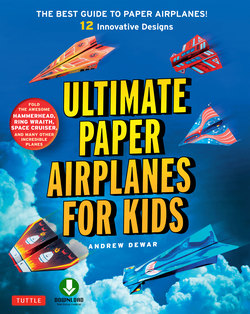Читать книгу Ultimate Paper Airplanes for Kids - Andrew Dewar - Страница 9
На сайте Литреса книга снята с продажи.
ОглавлениеCreating Lift
“Lift” is what holds flying things up. In an airplane, lift is made by the wing moving through the air. How? Let’s find out!
PUSHING ALL THE TIME
Did you know that air is pushing on us all the time? Still air pushes from every direction equally. (Our bodies push back the same amount, which is why we don’t feel it.) We can feel wind, because that’s moving air, which hits only one side of us and feels like a bigger push.
A shape that is curved on top and flat on the bottom is ideal for a wing profile. It will create lift when air flows over it, because the air flows faster over the top, reducing the pressure pushing down on that surface. The greater pressure pushing on the bottom lifts it up. This kind of cambered (curved) shape is called an airfoil. Why does the air on the top of the wing speed up? And why does that lower the air pressure there? It’s because of three special effects: the Coanda Effect, the Kutta Condition, and Bernoulli’s Principle.
Bernoulli’s Principle says that the faster a fluid flows, the less pressure it exerts. So if the air on the top of the wing is going faster, there’s less pressure pushing down. That means the higher pressure on the bottom of the wing pushes it up. And lift ensues!
The Coanda Effect says that fluids (like air and water) tend to stay attached to surfaces they flow over. This means that air follows the curve at the top of the wing. And because of the Kutta Condition, created by the sharp back edge of the airfoil, the air speeds up as it flows over the curve. It speeds up so much that it gets to the back of the wing faster than the air going under it!
KITES
Think about kites. They are a wing that stays in one place while wind moves over them. The wind wants to go in a straight line, so when a kite is in the way, the wind tries to push it aside, making it rise. This creates a lot of drag, too, which pushes the kite backwards at the same time. Without a string to hold it still, the kite would not be able to keep air moving over it. This is why airplanes based on kites (and there were a lot of them at first!) usually failed.
Paper experiment
TRY IT!
Here are two experiments you can try. First, blow over the top of a drooping sheet of paper. The paper will rise up and stand out straight, supported by the greater air pressure under it. Next, try touching a steady flow of tap water with the bottom of a spoon. You’d expect the spoon to be pushed away, but in fact it is pulled into the flow. That’s because the speed of the water reduces the pressure on the bottom of the spoon, and air on the other side pushes it.
Spoon experiment
know what?
The Wright brothers are famous for being the first to fly a powered airplane. But they had trouble at first. Their wings didn’t work! They put test models on their bicycles and rode around, and then made a little wind tunnel to test more models. But they didn’t know that small wings are different from big ones. The models that worked best were almost flat, but when they were turned into full-sized wings, they were too thin and hardly made any lift!
Making lift sounds simple, and it basically is. But lift doesn’t just pull upward. Remember, air pushes in all directions, so lift is produced anywhere that pressure has been reduced. In airplane wings, that means lift pulls forward and backward as well as up. You can change the amount of lift, and the direction in which it pulls, just by changing the wing’s angle.
Distribution of lift
ANGLE OF ATTACK
By increasing the angle of attack (the angle at which the wing hits the airflow) you can increase the amount of lift. Air going over the top of the wing has to go faster, and air striking the bottom creates more pressure (the kite principle). The bigger the angle, the more lift. But if the angle becomes too big, the Coanda Effect stops, and the air comes unstuck and gets turbulent. If that happens, the wing stops making lift and stalls. In other words, it stops flying.
More speed means more lift. But more lift is not necessarily better. Lift creates drag, which holds the wing and the airplane back. And drag increases much faster than the speed. When the airplane doubles its speed, the drag created by the wing quadruples! So more and more power is needed to go faster, in spite of the lift.
small angle, small lift
larger angle, more lift
too large an angle, no lift
know what?
Sometimes people say you can feel lift and drag for yourself by putting your hand out the window of a moving car. It’s true, but it isn’t a safe thing to do. Instead, try putting your hand close to the hose of a vacuum cleaner. Does it suck your hand? That’s because the air pressure is lower inside the vacuum, just like the top of a wing, and the thicker air outside is pushing your hand. Turn your hand sideways to the flow and then back to flat again. Feel the difference? That’s drag.
